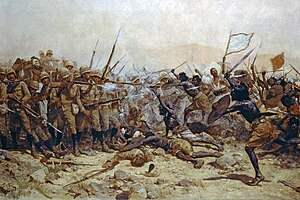Sougoulie
| Sougoulie | |||||||
|---|---|---|---|---|---|---|---|
| Part of Toubacterie | |||||||
 Ndjarendie soldiers under Saïkou Ahmed Bamba clash with Gaullican troops during the Battle of Ourafade | |||||||
| |||||||
| Belligerents | |||||||
|
Template:Country data Estmere |
Soubaka Dominion of Heaven Kambou Karanate Ichïamba | ||||||
| Commanders and leaders | |||||||
|
Baguette dude Crumpet dude Sausage dude |
Saïkou Ahmed Bamba Fatima Maal Jean-Paul Rugima | ||||||
| Strength | |||||||
|
Template:Country data Estmere 13,000 | 200,000 | ||||||
| Casualties and losses | |||||||
| 2,000 | 100,000 | ||||||
The Sougoulie was a major unsuccessful revolt against Euclean colonisation in Bahia that took place in 1883 and 1884. It began in Meyrout, which was used by the Gaullicans as a garrison point for their Tirailleurs Bahiens, on the 23rd of May 1883 after the local garrison mutinied in revolt against the Act of Bahian Quartering Reform. As news of the revolt spread, other localised revolts broke out across the subcontinent. These revolts aimed to bring back the return of local rule and often resulted in the reformation of previously existing Houregic states, posing a threat to Euclean control over the region. The revolts were eventually defeated in 1884, following the defeat of the Soubaka Dominion of Heaven under Saïkou Ahmed Bamba. The name of the event is contested by historians as while the Bahian name of Sougoulie is widely accepted in Bahia, Euclean scholars disagree on the magnitude of the revolts. As such, the terms Bahian Mutiny, Tirailleur Mutiny and Bahian Rebellion of 1883 are also used.
While the catalyst cause of the Sougoulie was quartering reform within the Gaullican army, the revolts soon took a broader aspect of resistance against the cultural and religious repression of Bahian society by their Euclean colonisers as well as the economic expropriation of lands and resources by Euclean corporations. While many Bahians, particularly amongst the marginalised Irfanic and Fetishist pupulations, joined the revolts, many Sotirian Bahians instead fought alongside the Eucleans. The Sougoulie was a period of intense violence, particularly against the civilian population. Both sides were reported to have perpetrated massacres, with the Gaullican sack of Kambou being one of the most well-known examples.
In most cases, the revolts constituted a reactionary effort to reinstitute Hourege and the status quo before Toubacterie. There was not any major effort to cooperate between the different rebel groups, who often fought amongst themselves as well as fighting the Euclean forces. This division of resistance essentially doomed the revolts to failure, as they were unable to cross ethnic or religious lines against a common enemy and could therefore be defeated one by one. This failure was a key inspiration in the development of Pan-Bahianism, as the importance of a united struggle against colonialism was demonstrated.
Origins
Outbreak
Bahian divisions
The Revolts
Soubaka
Kambou
Ichïamba
Verizi Empire
As Estmerish forces continued advancing into the Plateau, the native villages in the Plateau realised that continuing the village system would inevitably mean that each village could be annexed into the Estmerish colony of Riziland. Thus, in 1881, the chieftains of the villages met in Munzwa to establish a neo-veRwizi Empire, known as the Verizi Empire, with the chieftain of Munzwa, Tamutswa being named Mambo of the Verizi Empire.
When word of the Sougoulie spread to the Plateau, Tamutswa called for all veRwizi chieftains to join the rebellion to "expel the Murungu" from Rwizikuru, and restore the veRwizi Empire under Mambo Tamutswa.
(TBC)